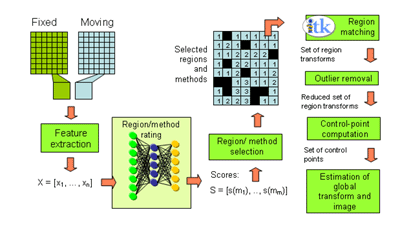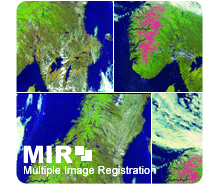Main activities
Main activities
Development of an adaptive method for image registration: Methodology for intelligent selection of methods have been developed and combined with existing methods and tools for image matching and registration in the first project phase (2004-2005). The approach works by dividing the pair of images to be co-registered into smaller sub-regions and extracting features from each region. Based on the extracted features the performance of each of the available methods is predicted by using a neural net. For regions with sufficiently high scores, the method with the best rating is used to perform a local co-registration. This results in a set of local transformations, which is used to find the global transformation.

Development of prototype system: A first version of a prototype system for adaptive image registration has been developed (2004-2005). The methodology described above has been implemented in a software tool, which is developed in ENVI/IDL and C/C++.
Performance evaluation and improvement: The approach has been tested on time series of optical and radar EO images and results are promising. The methods have demonstrated ability automatically to select the areas in the images that are best suited for registration, discarding regions covered by snow and very homogeneous areas with little information. A more thorough evaluation of the performance was carried out in 2007, in addition to specific improvements and extensions.
Inclusion of multi-resolution strategy: To be able to handle larger distortions, a multi-resolution approach, where registration is performed at multiple resolution levels, has been included as a preprocessing step. The basic idea is that registration is first performed at a coarse scale where the images have fewer pixels. The spatial mapping determined at the coarse level is then used to initialize registration at the next and finer scale. This process is repeated until it reaches the finest possible value. This coarse-to-fine strategy greatly improves the registration success and also increases robustness eliminating potential finer-scale local optima by including coarser scales.
Integration in ESA’s software framework: The software tool has also been integrated in the KEO software framework provided by ESA.

